Keynotes 11Japan
1185-1600 Medieval Japan: The Age of the Samurai
I. The Military Shogunate at Kamakura (Minamoto clan)
(1185-1336)
- Decline of Fujiwara (= ruling clan at court, ruled
858-1158) politics: Descendants of the Fujiwara clan were cut off from the
principal line. This implied that they lost their right of inheritance of
political top positions in the capital. New 'side' lines were created to accomodate
offspring of these side lines given the names of Taira and Minamoto, with
their prominent leaders Yoritomo and Yoshitsune who resided at Kamakura (Tokyo).
Taira and Minamoto came to be prominent military leaders in the provinces,
based on their prestigious descendence.

Location of Kamakura
- Bushi = warriors become dominant during
this age of constant warfare between
- contending shoen [=large
private estates] with their private protective forces,
- military officials sent from the central government to rule the provinces
who were commanding their own armies,
- and pirates,
while all parties pretended that imperial
authority was unquestioned.
 Samurai
Samurai
- Soon Fujiwara, Taira, and Minamoto developed into
contending forces striving for power by strategic measures such as marriages
with members of the imperial clan and by warfare. The Minamoto clan became
the dominant power: Minamoto Yoritomo's position is acknowleged by the court
by awarding him with the title 'Shogun' ('Generalissimo').
- He installs a new military administration called
bakufu ('tent-government'; name was chosen because soldiers lived
in tents) which officially complemented the civil administration of the court,
but in fact was identical with the government.
- Taira clan domains are confiscated and distributed
among Yoritomo's followers. Thus he distributes power strongholds over the
entire country. In addition, two representatives of the Kamakura bakufu
reside at the court in Kyoto: Yoritomo controls central and local politics.
When he eliminates his brother Yoshitsune his power is only challenged from
abroad: The Mongol invasion - especially the extraordinary costs of building
a fleet to fight the Mongols- marks the beginning of Kamakura decline. The
shogunate comes to an end when emperor Go-Daigo ascends the throne in 1318
and attempts to bring back power to the central government and strengthen
his own position.
- His political innovations are quickly suppressed
by another ascending shogun: The Ashikaga shogun seizes Kyoto in 1336, replaces
the emperor, and officially announces the founding of his shogunate in 1338.
Do-Gaigo flees to Koshina where he sets up his own court which persists until
1392. The reunion of the courts marks
the begin of the Muromachi Period.
During the Kamakura period Buddhism, just as Shinto,
is no longer a religion of the elite. Anyone searching for salvation can follow
Buddhist teachings. Especially appreciated by the oftentimes illiterate bushi
is the Zen sect, brought to Japan by monk Eisai in 1191. Enlightenment could
be obtained by practicing meditation and did not require intense study of Buddhist
texts. This also holds for the True -Pure Land- Sect (founded in 1175) which
concentrated on the Lotos Sutra as the only text that needed to be studied.
II. The Ashikaga Shogunate (1378-1573)
The Muromachi Period (1392-1568)
- The Ashikaga Shogunate resides in Muromachi, a district
of Kyoto.
- During this period the feudal lords (daimyo=
great holders of private land) and their samurai take over the provincial
administration, including control of taxation and corvée, construction
works, transportation (especially for their armies).

Distribution of Daimyo territories
Trade with Korea and China is intensified. In the diplomatic
missions to China, Japanese merchants are even accepted participants of the
trade missions, after Japan had taken tributary status.
- Imports from China: Porcelain, silk, books, paintings,
copper cash (used as the Japanese currency)
- Exports to China: Copper, silver, sulphur, swords,
fans, paper, lacquerware
1545 The Portuguese arrive in Nagasaki and establish
a trading post.
1549 Franz Xavier comes to Japan.
Muromachi culture excells in architecture (Golden and
Silver Pavilions in Kyoto), the art of flower arrangement (ikebana),
tea ceremony, and Noh drama.

Kinkakuji Pavilion
1563-1616 Tokugawa Ieyasu: during his rule in the north
he plans to extend trade relations, even considers to invite Spanish traders
to Edo, while the Portuguese concentrate their trade activities on Nagasaki.
 Tokugawa Ieyasu
Tokugawa Ieyasu
In 1573 the Ashikaga shogunate comes to an end when
general Oda Nobunaga (1534-1582) destroys
the Enryakuji monastery and mercilessly slaughters his opponents in the civil
war between the daimyos.
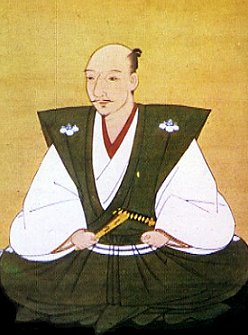 Oda Nobunaga
Oda Nobunaga
After his assassination he is succeeded by General Toyomi
Hideyoshi in 1583.
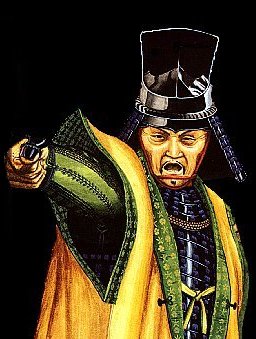 Toyomi
Hideyoshi (1536-1598)
Toyomi
Hideyoshi (1536-1598)
Hideyoshi re-constructed and fortified Himeji Castle.

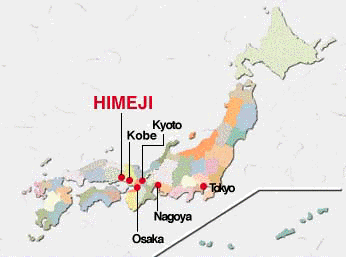
Hideyoshi instantly assures the subserviency of the
strongest daimyo in the north: Tokugawa Ieyasu and his subordinate
daimyos.
In 1590 Japan is unified for the first time. Like Ming
emperor Hongwu, Hideyoshi is extremely suspicious; he disarms all non-samurai
('sword hunt') and freezes the hierarchical structure of society. In 1587 he
bans all missionaries. One of the reasons for his opposition in later life against
the Catholic missionaries is that he wants to avoid divided loyalties among
his population. To him loyalty to a foreign authority [=the pope] can only mean
conflict. In 1597 a merciless persecution of Christians eliminates Catholicism
from Japan almost completely.
In order to keep the daimyos under control
he develops the 'system of alternate residence': He calls the daimyos
to the capital where their families have to reside on a regular basis. This
keeps them moving constantly on five major roads between their territories and
the capital - a costly trip when having to bring presents to the court and having
to finance the travel which could take several months every other year.

Hideyoshi creates his own currency (copper, silver,
and gold coins). After his death in 1598 (shortly before the envisioned invasion
of China he had plannend) Tokugawa Ieyasu comes to power in 1600 after defeating
all contenders in the battle of Sekigahara.
1603 Tokugawa Ieyasu takes the title of shogun
and becomes the first ruler of the peaceful dynastic reign of the Tokugawa shoguns
which was to last for 250 years. He and his followers rule from Edo (Tokyo)
which also becomes the residence of the emperor when the magnificent castle
is finished that Ieyasu built for the Tenno. It remains the capital of Japan.
Following the Neo-Confucian model morals, education,
and a hierarchical social order are emphasized.
The society is divided into four classes which are not
allowed to change their position:
- samurai
- peasants
- artisans
- merchants
- eta (Outcasts: people with professions that
are considered impure.)
Ieyasu begins to build a modern navy and opens Japan
for trade to the English and the Dutch who reside on the island of Deshima from
1630 to 1830 and remain the only foreign nation that is allowed trade after
the step into seclusion in 1633 (ban on all foreign travel) and 1639 (reduction
of all foreign trade to contacts with China and Holland) taken by shogun
Iemitsu. The Dutch export silver, copper, and porcelain, and bring silk and
spices to Japan. Foreign books are banned.
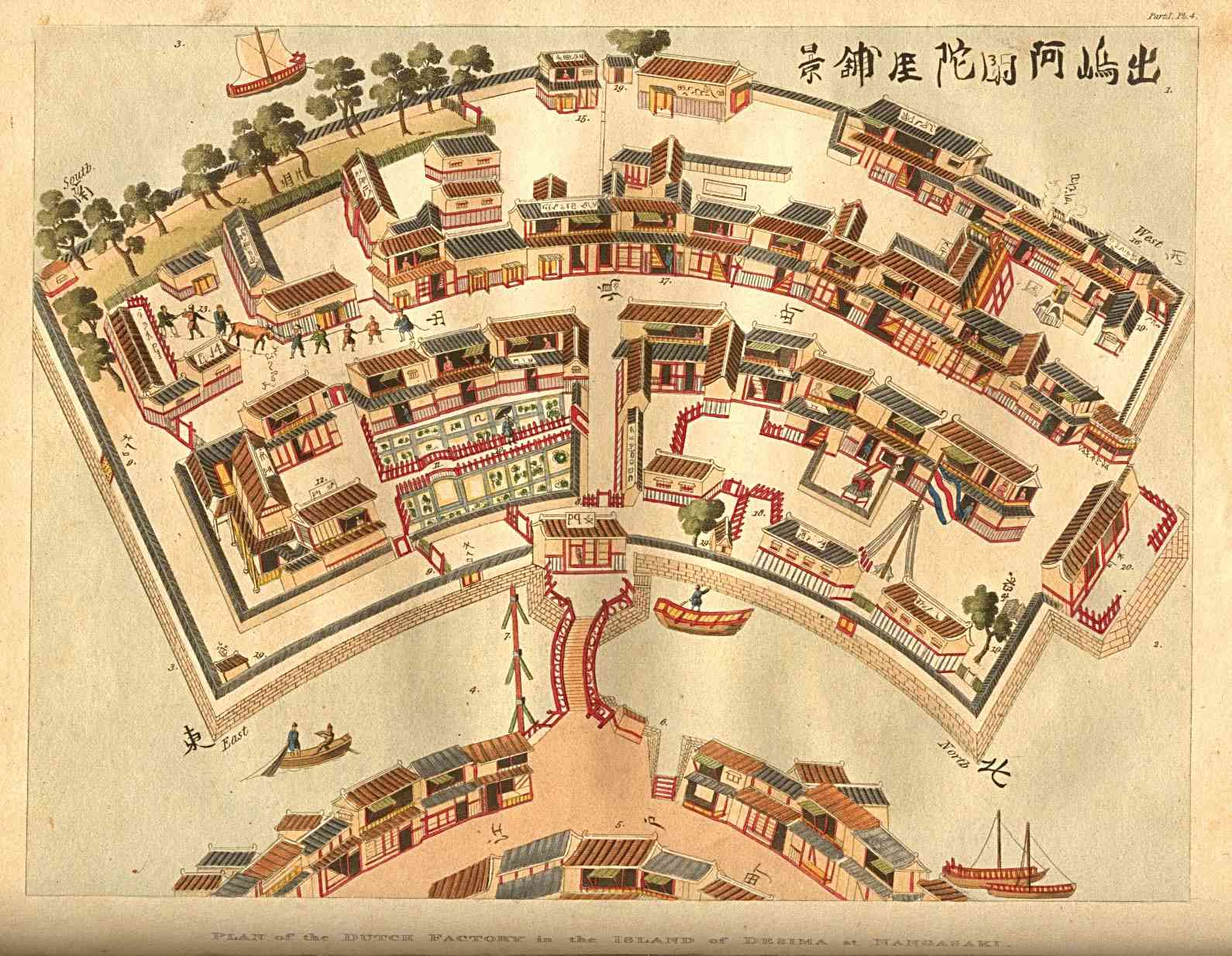
European warehouses on Deshima

Foreign merchant ships arriving at Deshima (Nagasaki)
Domestic trade and agricultural production thrive, popular
culture flourishes: Kabuki thater and ukiyo-e woodblock carvings
become popular in the cities.
In 1720, the ban on foreign books is cancelled, new
teachings enter Japan from China and Europe (Dutch Learning).
In the end of the 18th century external pressure first
by Russia, then by other European nations begins to threaten an economically
shaking stability. In 1854 the American Commodore Perry forces the Tokugawa
government to open a limited number of ports for international trade.
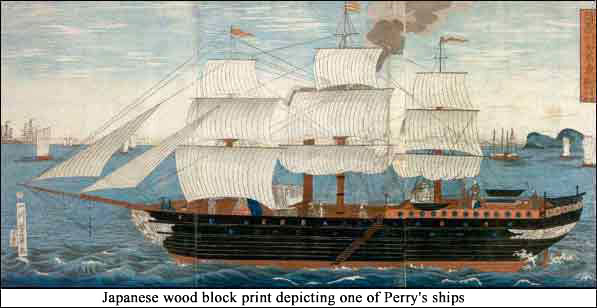
Only when the Tokugawa government falls due to political
pressure, the power of emperor Meiji is restored. He initiates the Meiji restoration
during which Japan opens its borders for trade and travel in 1868.

 Samurai
Samurai

 Tokugawa Ieyasu
Tokugawa Ieyasu  Oda Nobunaga
Oda Nobunaga Toyomi
Hideyoshi (1536-1598)
Toyomi
Hideyoshi (1536-1598)




